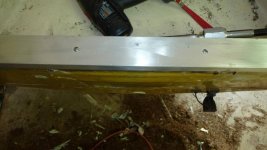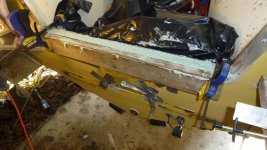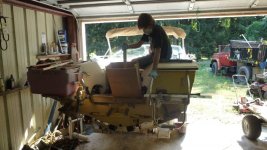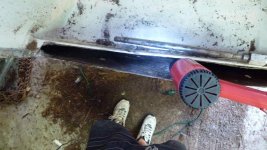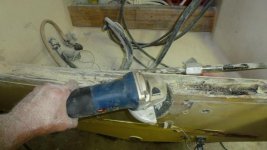Destroyer
God
I think you might be a little confused Roycie. They're talking about replacing a rotted out transom. Sani-Tred is a waterproofing compound. It might be great for the outside of the bilge skin of the fiberglass, but it's an elastic polymer and will not fill the void that a transom replacement requires. Plus, the last thing you want is a transom that flexes.
The problem with our boats is that the transom is made of marine plywood, with fiberglass laminated to both the inside and outside faces, effectively encapsulating the wood. But people drill holes in the transom to mount things like transducers, speed pitot's, battery hold downs, bilge pumps, etc., etc, and then they don't properly seal those holes. Over time, water seeps into the plywood through those holes and rots the wooden core, weakening the transom and making operating the boat with a large, heavy engine hanging on it unsafe. In fact, there was just such a disaster off the Jersey shore last year, where the transom cracked open and the boat sank.
The easy cure for this is to take off the top cap of the transom, hollow out all the wood and then pour a compound into that void to fill the space with a hard substance that doesn't rot, will support the weight of a large engine and the torque forces associated with that, plus can handle to force of the engine pushing on it, and it, in turn, pushing the rest of the boat hull through the water. The not as easy cure is to remove one of the sides of the fiberglass, remove all the rotted wood and replace it with new marine grade plywood, then replace the removed panel and fiberglass everything back together. Properly done, both solutions work effectively, but since the pourable transom repair will never rot out like the wooden repair, it's the process of choice.
Hope this helps clear up the misunderstanding.
The problem with our boats is that the transom is made of marine plywood, with fiberglass laminated to both the inside and outside faces, effectively encapsulating the wood. But people drill holes in the transom to mount things like transducers, speed pitot's, battery hold downs, bilge pumps, etc., etc, and then they don't properly seal those holes. Over time, water seeps into the plywood through those holes and rots the wooden core, weakening the transom and making operating the boat with a large, heavy engine hanging on it unsafe. In fact, there was just such a disaster off the Jersey shore last year, where the transom cracked open and the boat sank.
The easy cure for this is to take off the top cap of the transom, hollow out all the wood and then pour a compound into that void to fill the space with a hard substance that doesn't rot, will support the weight of a large engine and the torque forces associated with that, plus can handle to force of the engine pushing on it, and it, in turn, pushing the rest of the boat hull through the water. The not as easy cure is to remove one of the sides of the fiberglass, remove all the rotted wood and replace it with new marine grade plywood, then replace the removed panel and fiberglass everything back together. Properly done, both solutions work effectively, but since the pourable transom repair will never rot out like the wooden repair, it's the process of choice.
Hope this helps clear up the misunderstanding.


